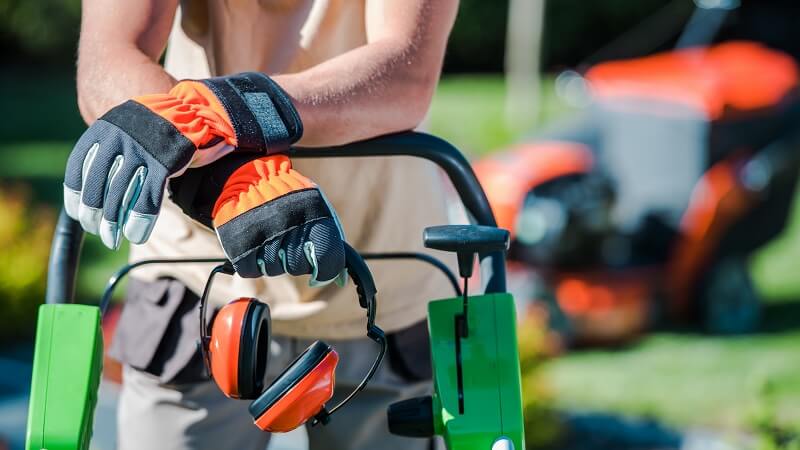
Understanding your funding options and applying for the right small business loan for your business can be confusing. Our Industry Funding guides make it easy to compare your funding options and choose the right loan for your business, whether you’re just starting up or are looking to grow an existing business.
Getting Started with Landscaping Business Loans
There are nearly 622,000 landscaping and lawn maintenance businesses in the US, including specialties such as:
- Landscape architects and designers
- Landscape maintenance and technicians
- Interior landscaping
- Arborists and botanists
- Groundskeepers
- Heavy equipment operators, and more.
Globally, the landscaping market generated $11.46B in revenue in 2021, with a further projected increase of 0.9% in 2022. Thirty-one percent of landscaping businesses in the USA reported increases in local demand as their customers began spending more time at home in 2020, with landscape maintenance becoming the fastest growing service offering. And landscaper employment is expected to continue increasing through 2030, with an additional 8% growth projected and over 173,000 new job openings expected in 2023 alone.
As demand for landscaping services increases, so are operating costs—operating costs grew 11.9% in 2021. Along with these cost increases, supplies and materials are also becoming harder to find and labor shortages continue to impact the landscaping industry. This can lead to cash flow problems that may make it difficult for landscapers to meet increased demand and continue to grow their business.
Landscaping business loans can help landscapers of all sizes and specialties meet these challenges and continue to grow.
Landscaping Business Loan Options
Long and short-term law firm funding options are available, including:
- SBA landscaping business loans
- Bank loans
- Alternative funding
- Lines of credit
- Equipment financing
Let’s take a look at each of these options.
1. SBA landscaping business loans
Small Business Administration (SBA) loans are one of the most popular small business funding options. They offer the lowest rates, longest terms, and highest loan amounts, but they also have the longest application process with the most extensive paperwork requirements and the strictest eligibility criteria. You must be able to provide at least two years of detailed financial documentation, and only businesses with the strongest credit scores are approved.
SBA loans are not actually granted by the SBA—they are assessed, approved, and disbursed by partnering commercial lenders, and are simply guaranteed by the SBA up to 85% of the loan amount. This reduces the risk to the lender and, in theory, encourages them to approve more loans.
Multiple types of SBA landscaping business loans are available, including:
- 7(a) Guaranteed Loans: With loan limits as high as $5M, terms as long as 25 years, and the lowest rates available, 7(a) loans are the most popular SBA funding option. These loans typically require collateral, but have the fewest restrictions on how you can use your funding. Express loans are also available, with a turnaround time of 36 hours or less. Express loans typically don’t require collateral for amounts under $25,000.
- 504 Loans: These long-term, fixed rate loans are commonly used to purchase real estate and equipment. Disbursed by community development corporations through commercial lending institutions, 504 Loans require the borrowing business to use their financing to create or retain jobs, or uphold other public policy goals such as rural development, revitalizing a business district, or supporting minority-owned businesses.
- Microloans: Available to a maximum amount of $50,000 with a maximum repayment term of 6 years, microloans can be used for working capital, inventory or supplies, furniture or fixtures, or machinery or equipment, and are available through select non-profit, community-based organizations.
Regardless of which type of SBA landscaping business loan works best for you, the application process for SBA funding is more intensive than any other lender with the strictest approval requirements. It can take weeks or months to get a decision and most applicants are rejected, especially those with low credit, seasonal businesses, businesses with a history of unstable cash flow, or those seeking short-term financing or smaller loan amounts.
2. Bank loans for landscaping businesses
Landscaping businesses may be able to access the funding they need from traditional commercial lenders like banks or credit unions, especially if they have an established relationship with their lender. Terms and rates for these landscaping business loans will be competitive, but may not be as low as the SBA and will ultimately depend on the size of the loan and your business’s financial history.
Lending requirements may not be as strict as the SBA, but landscaping business loans may still be difficult to acquire from banks due to the perception of risk and factors like seasonality, lower margins, and unstable cash flow. Banks tend to prefer granting loans to larger businesses and loans for larger amounts, which can make it tough for small landscaping businesses and those looking for smaller loan amounts to get the funding they’re seeking.
You may have better odds of approval if you already have a relationship with a lender, but similar to the SBA, it can take weeks or months for a bank to process a landscaping business loan application, and approval is never guaranteed.
3. Alternative landscaping business loans
Alternative landscaping business loans are available from direct online lenders like Greenbox Capital®. Loan amounts are typically lower with shorter terms and higher rates than SBA or bank loans, but these lenders have more flexible approval requirements with faster application turnaround, making them an ideal option for landscaping businesses that may not be approved by other lenders.
Approval for alternative landscaping business loans is based on the overall health and potential of your business, with less focus on your financial history and credit score. These factors will still be considered, but they will be reviewed alongside other factors like vendor relationships, public reputation, and cash flow.
Some alternative lenders offer more traditional forms of funding like short term loans and lines of credit, while others like Greenbox Capital specialize in innovative non-loan financing options like merchant cash advances.
There are typically no restrictions on how funds from alternative lenders can be used. Alternative funding often does not require collateral, making these lenders an ideal option for landscaping businesses that don’t meet the strict criteria of the SBA and banks. With faster turnaround—sometimes in as little as one business day—alternative lenders may also be the best option for landscaping businesses that need fast funding or don’t have time to navigate the long, complicated application process of these lenders. Alternative lenders are also more likely to lend to newer businesses, though some will not lend to businesses in operation for less than 6 months.
4. Lines of credit
Available from both traditional and alternative lenders, lines of credit for landscaping businesses function similarly to business credit cards but with longer terms and lower rates. Alternative lenders may have easier approval requirements than banks, but credit limits may also be lower and rates may be higher than traditional lenders.
Because lines of credit are revolving, business owners can draw and repay from the line as needed and will only ever pay interest on the amount borrowed. With no restrictions on how funds can be used, lines of credit are the most flexible form of landscaping business loan.They’re typically used for covering unexpected expenses, making occasional purchases like inventory or new equipment, or managing other major expenses that don’t require a larger loan but can still strain your cash flow.
5. Equipment financing
Purchasing and maintaining equipment is one of the most capital-intensive aspects of running a landscaping business. Equipment financing is designed specifically to help businesses fund the purchase of new equipment, such as heavy machinery, storage equipment, and tools. The equipment or inventory acts as collateral to secure the loan, which may make this form of funding easier for newer landscaping businesses or those with lower credit scores to acquire.
Landscapers can use equipment financing to purchase small tools like hedge shears, trowls, shovels, and pruners, as well as large or heavy machinery like mowers, power washers, trimmers, vehicles, stump grinders, trailers, leaf blowers, and more. Equipment financing is also ideal for purchasing safety equipment like ear protection, gloves, and safety apparel for your staff.
What Is The Best Loan For Landscapers?
The best landscaping business loan depends on how much funding you need, your financial history, your monthly sales, and how you plan to use your funding.
For short-term funding, non-loan financing such as merchant cash advances or invoice factoring can provide a quick infusion of working capital that can be used for any purpose, such as maintaining cash flow, covering unexpected expenses, hiring staff, or fueling your business’s growth.
For long-term funding, SBA 7(a) loans offer the highest loan amounts, lowest rates, and longest terms, but they are the most difficult to acquire. Bank loans may have easier approval requirements, but they can still be difficult for landscaping businesses to access due to perceived risk and seasonality. If you don’t meet the strict approval criteria of these lenders, alternative lenders also offer term loans, though terms may be shorter than SBA and bank loans.
For fast funding, alternative lenders are always your best choice. These lenders can approve and deposit funds in as little as one business day, while the SBA and banks can take weeks or months with no guarantee of approval.
How To Use Landscaping Business Loans
As landscaping businesses navigate increased demand alongside labor and supply shortages, landscapers will face a number of opportunities to grow:
- New home sales: New home sales mean more opportunities for landscapers to service new homeowners. Sixty-two percent of landscaping customers are single-family residential homes, with the average homeowner spending $100-$200 per month on general landscaping maintenance, lawn care, gardening, and upkeep. Landscaping business loans can help you hire staff and market your business so that you can take advantage of this increased demand and begin building loyalty with new homeowners.
- Multi-seasonal spaces: People want to spend time outdoors more than ever, including in the winter. Landscaping businesses take advantage of this change in consumer behavior by developing and offering services that will help consumers create a functional, safe space that can be used year-round. Use funding to purchase new equipment, bid on larger projects, acquire materials, hire specialized staff to help with hardscaping and designing cold-weather spaces, or even develop new, seasonal service offerings such as holiday lighting or decoration services for Halloween or Christmas.
- Commercial demand: Demand from commercial businesses, such as malls, hospitals, and other large businesses is also increasing. Landscaping business loans can provide the working capital you need to acquire supplies and materials to bid on these projects or hire staff to handle larger projects or more clients, as well as boost your marketing so other businesses can find you and book your services.
- Infrastructure Investment and Jobs Act (IIJA): IIJA allocated $490 million to support natural infrastructure resilience and urban forests in 2022. Landscaping businesses can take advantage of this federal funding by familiarizing themselves with the process of bidding on public projects and boosting stock of native plants and trees. Use your landscaping business funding to shore up cash flow while you learn about the public bidding process or to stock up on native plants and trees for public projects.
- New services: Use landscaper funding to expand your service offering so you can up- or cross-sell other services once a project is complete. Offering new services like hardscaping, including things like construction, building fire pits, and creating accessible outdoor areas with pavilions and electric hookups for space heaters, motorized shades, and other equipment can give you a competitive edge over other landscapers who focus purely on maintenance and plant care.
- Efficient machinery: Investing in multi-purpose machinery is a great use of landscaping business funding. Machine versatility, in which one machine can handle multiple tasks, will allow landscaping businesses to improve their ROI, reduce costs associated with transporting multiple machines, and eliminate jobsite clutter. Traditional attachments like forks, trenchers, and buckets will remain popular, while stand-on skid steers and attachments for these machines like tree grapples and backhoes will grow.
- Technology: Use landscaper funding to purchase and implement landscape management software to help with quoting, scheduling, invoicing, and managing client relationships so you can work more efficiently and focus on tasks that generate revenue. You can also use landscaping business funding to implement sustainable irrigation practices with remote technology like controllers.
- Aversion to pesticides: As consumers grow more averse to pesticides, landscaping businesses will have an opportunity to develop and promote more landscape and lawn maintenance services, such as 100% manual weed removal. Landscaping business funding can help you boost your marketing so you can promote these services online or offline, generate more revenue, and stand out from your competition.
- Edible plants: 67% of adults are currently growing or are planning to grow edible plants. Use landscaping business funding to stock up on edible plants and take advantage of this increasing demand.
Landscaping business loans can also help you meet the challenges of running a landscaping or lawn maintenance business, including:
- Higher nursery input costs: The cost of seeds, containers, soil, labor, and anything else required to grow plants is up 12-14% over pre-pandemic levels, and these costs are expected to stay high—fertilizer prices are increasing 25-30% and other resources are showing a continued 5-15% increase in pricing. Landscaping business funding can provide the working capital you need to absorb these increased costs and acquire the materials you need to maintain your operations.
- Labor: Limitations to the H-2B program can make it difficult to hire workers to help meet increasing demand, and 43% of landscaping business owners worry that an ongoing shortage of quality labor will slow their growth in the next three years. Landscaping business loans like merchant cash advances can help your business hire proactively and offer competitive compensation packages that will attract new hires and retain existing staff. Learn more about how merchant cash advances can help you deal with staff shortages.
- Drought: As droughts become more common, homeowners are increasingly looking for ways to limit water use. Xeriscaping—gardening involving the use of drought-tolerant or low-water plants, practical turf, and efficient irrigation—is growing in popularity as people look to create landscapes and gardens that require less water. States across the country, especially in drought-prone areas, are also focusing on products that allow the efficient use of water; for example, nine states now require only pressure-regulating spray sprinkler bodies to be used in irrigation systems. Landscaping business loans can provide the capital you need to adjust your product and service offerings to meet these changing demands and regulations.
- Supply chain: Trouble accessing fertilizers, chemicals, plant materials, engine-powered equipment, and other essential supplies is creating challenges for landscaping businesses across the country. Material shortages are forcing landscapers to change project timelines to accommodate delays and longer times. Use landscaping business funding to maintain your cash flow during these waiting periods or to develop relationships with new suppliers so you can keep working if your usual vendors are back-ordered or out of stock.
- Seasonality: Landscaping businesses are more susceptible to seasonality than other industries, especially in cooler climates. Cash flow can suffer in the off-season, making it difficult to maintain operations and continue to grow during your busy season. Applying for landscaping business funding during your busy season when cash flow is strong can help ensure that you have cash flow available during your off-season so that you’re in the best possible position next season.
- Slow paying clients: If your landscaping business services commercial clients, you may rely more heavily on invoicing clients than taking payment at the time of service. This delay in receiving payment can significantly impact your cash flow, especially as you contend with higher materials costs and supply chain challenges. Invoice factoring can help you bridge the gap between these payments so that you can maintain your cash flow and continue running smoothly.
How To Apply for Landscaping Business Loans
Landscaping businesses are often considered to be “high-risk” loan applicants because of factors like seasonality, low margins, and cash flow shortages. This means applicants will have more hurdles to overcome when applying for funding from lenders like the SBA or a bank.
All lenders will require you to explain how you intend to use your landscaping business loan, as well as how you plan to pay it back. Traditional lenders will require a detailed business plan while alternative lenders are typically satisfied with a purpose statement. It’s best to have this information prepared ahead of time in order to reduce any delays in receiving your funding.
Regardless of which lender or loan type you’re seeking, make sure you have a firm understanding of your business’s background and financials before you apply, including:
- Operating history
- Revenue and profitability
- Personal and business credit scores
- Collateral
It’s also a good idea to prepare your financial statements and documentation in advance in order to reduce any wait times. Compile the following before you apply:
- Bank statements
- Profit and loss statements
- Personal and business tax returns
- Cash flow forecasts
Check out our small business loan documentation checklist for a comprehensive list of required paperwork.
Frequently Asked Questions
How much does it cost to start a landscaping business?
It can cost between $15,000-$50,000 or more to start a landscaping business, depending on your location, the equipment you need to purchase, and the type of services you plan to offer. If you already have access to a truck, garage space, and equipment, your start up costs will be lower.
What do I need to start a landscaping business?
You’ll need some heavy equipment to start a landscaping business, as well as other tools and supplies, including:
- Lawn mower
- String trimmer
- Leaf blower
- Truck and trailer
- Storage for your supplies
- Gardening tools like shovels, rakes, hoes, aerators, saws, and trimmers
- Raw materials like soil, mulch, plant materials, etc.
- Construction materials such as access to lumber, paving supplies, etc.
Greenbox Funding Options for Landscapers
As an alternative lender, Greenbox Capital® can approve more landscaping business loans than traditional lenders. We can also approve loans for landscapers faster, with funds deposited in as little as 24 hours. We offer several types of landscaper funding to help grow your business, including merchant cash advances, invoice factoring, lines of credit, and more, with funding from as low as $3,000 up to $500,000.
Greenbox Capital funds all landscaping and lawn care specialties. Our expert Funding Advisors will work closely with you to determine which funding option will help you achieve your goals without compromising your business’s cash flow.
Sources
- “19 Landscaping Industry Statistics [2022]: Market, Trends, Projections“. Chris Kolmar. Zippia. April 30, 2022.
- “2020 Industry Pulse: Despite the news, an amazing year“. Sarah Webb, Abby Hart, Seth Jones, Christina Herrick. Landscape Management. December 14, 2020.
- “Four Key Landscaping Industry Statistics from 2022 Report“. GoMaterials. March 2, 2022.
- “How Much Does Landscaping Cost?” Daniel W. HomeGuide.
- “Industry Outlook 2022“. LandscapeBusiness. January 24, 2022.
- “Landscape and Industry Trends for 2022“. National Association of Landscape Professionals. December 20, 2021.
- “Landscaping Services in the US – Market Size 2002–2028“. IBISWorld. June 23, 2022.
- “Landscaping services in the U.S. – statistics & facts“. Statista Research Department. September 26, 2022.
- “Lawn, Landscaping Industry Outlook Positive for 2022“. Jon Minnick. ForConstructionPros.com. February 20, 2022.
- “Mid-Year Check Up: Lawn and Landscape Companies Report on Their Revenue for 2020“. National Association of Landscape Professionals. July 28, 2020.
- “Occupational Outlook Handbook: Grounds Maintenance Workers“. U.S. Bureau of Labor Statistics. October, 2022.
- “The Landscaping Industry: How Far It’s Come And Where It’s Headed“. Tammy Sons. Forbes Councils Member. February 3, 2022.
- “What Does It Cost to Start a Lawn Care Business?“. Stephen Kime. LawnStarter. May 3, 2022.




